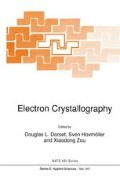Abstract
The intensities of a sufficient number of X-ray diffraction maxima determine the structure of a crystal, that is, the positions of the atoms in the unit cell of the crystal. The available intensities usually exceed the number of parameters needed to describe the structure. From these intensities a set of numbers |E H |can be derived, one corresponding to each intensity. However, the elucidation of the crystal structure also requires a knowledge of the complex numbers E H =|E H |exp(iф H ), the normalized structure factors, of which only the magnitudes |E H | can be determined from experiment. Thus, a “phase” фH, unobtainable from the diffraction experiment, must be assigned to each |E H |, and the problem of determining the phases when only the magnitudes |E H | are known is called the “phase problem”. Owing to the known atomicity of crystal structures and the redundancy of observed magnitudes |E H |, the phase problem is solvable in principle.
Probabilistic methods have traditionally played a key role in the solution of this problem. They have led, in particular, to the so-called tangent formula which, in turn, has played the central role in the development of methods for the solution of the phase problem. A number of computer programs, stressing different aspects of the central theme, have proven to be particularly effective.
Finally, the phase problem may be formulated as one in constrained global optimization. A method for avoiding the countless local minima in order to arrive at the constrained global minimum leads to the Shake-and-Bake algorithm, a completely automatic solution of the phase problem for structures containing as many as 600 atoms when data are available to atomic resolution.
Access this chapter
Tax calculation will be finalised at checkout
Purchases are for personal use only
Preview
Unable to display preview. Download preview PDF.
References
Harker, D. and Kasper, J.S. (1948) Phases of Fourier coefficients directly from crystal diffraction data, Acta Cryst. 1, 70–75.
Karle, J. and Hauptman, H. (1950) the phases and magnitudes of the structure factors, Acta Cryst. 3, 181–187.
Sayre, D. (1952) The squaring method: a new method for phase determination, Acta Cryst. 5, 6065.
Katie, J. and Hauptman, H. (1956) A theory of phase determination for the four types of noncentrosymmetric space groups 1P222, 2P22, 3P12, 3P22, Acta Cryst. 9, 635–651.
Hauptman, H.A. (1991) A Minimal Principle in the Phase Problem, in D. Moras, A.D. Podnarny & J.C. Thierry (eds.), Crystallographic Computing 5: From Chemistry to Biology, IUCr Oxford Univ. Press, pp. 324–332.
DeTitta, G.T., Weeks, C.M., Thuman, P., Miller, R. and Hauptman, H.A. (1994) Structure solution by minimal function phase refinement and Fourier filtering: Theoretical basis, Acta Cryst. AS0, 203–210.
Weeks, C.M., DeTitta, G.T., Hauptman, H.A., Thuman, P., and Miller, R., (1994) Structure solution by minimal function phase refinement and Fourier filtering: II. Implementation and applications, Acta Cryst. A50, 210–220.
Yao, J.-X. (1981) On the application of phase relationships to complex structures. XVIII. RANTAN–random MULTAN, Acta Cryst. A37, 642–664.
Debaerdemaeker, T., Tate, C. and Woolfson, M.M. (1988) On the application of phase relationships to complex structures. XXVI. Developments of the Sayre-Equation tangent formula, Acta Cryst. A44, 353–357.
Woolfson, M.M. and Yao Jia-xing (1980) On the application of phase relationships to complex structures. XXX. Ab initio solution of a small protein by SAYTAN, Acta Cryst. A46, 409–413.
Miller, R. and Weeks, C.M. (1997) Shake-and-Bake: Applications and advances, in S. Fortier (ed.), Direct Methods for Solving Macromolecular Structures, Kluwer Academic Publishers, Dordrecht, The Netherlands, 25th Course, Intl. School of Crystallography, NATO ASI Series, Erice, Sicily, May (1997).
Author information
Authors and Affiliations
Editor information
Editors and Affiliations
Rights and permissions
Copyright information
© 1997 Springer Science+Business Media Dordrecht
About this chapter
Cite this chapter
Hauptman, H.A. (1997). The Phase Problem of X-ray Crystallography: Overview. In: Dorset, D.L., Hovmöller, S., Zou, X. (eds) Electron Crystallography. NATO ASI Series, vol 347. Springer, Dordrecht. https://doi.org/10.1007/978-94-015-8971-0_9
Download citation
DOI: https://doi.org/10.1007/978-94-015-8971-0_9
Publisher Name: Springer, Dordrecht
Print ISBN: 978-90-481-4965-0
Online ISBN: 978-94-015-8971-0
eBook Packages: Springer Book Archive

